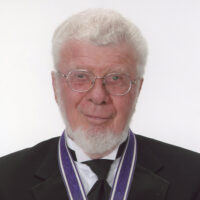
2006 Kyoto Prize Laureates
Biotechnology and Medical Technology
/ Immunologist and Geneticist
1931 - 2013
Professor, Stanford University
2006
11 /11 Sat
Place:Kyoto International Conference Center
Future of FACS Technology: Application to Biomedical Research
2006
11 /12 Sun
13:00 - 17:00
Place:Kyoto International Conference Center
Dr. Leonard Arthur Herzenberg took the lead in developing a flow cytometer called the Fluorescence-Activated Cell Sorter (FACS) that automatically sorts viable cells by their properties. Combining fluorescent-labeled monoclonal antibodies as FACS reagents with this instrument, he made an enormous contribution towards the dramatic advancement of life sciences and clinical medicine.
Dr. Leonard Arthur Herzenberg is an immunologist and geneticist who took the lead in developing a flow cytometer called the Fluorescence-Activated Cell Sorter (FACS) that automatically sorts viable cells by their properties and collects them. He came up with the idea of an instrument that sorts viable cells by their properties while searching for ways to investigate the functions of T-cells and B-cells, two major types of lymphocytes. Organizing a handpicked team of scientists and engineers, he modified a particle separator that fractionated particles by size, which had been developed at Los Alamos National Laboratory. With a primitive model they developed, in 1969 they became the first to successfully sort fluorescent-labeled cells that were still functional after collection. They continued improving the instrument and they successfully built a commercial version in early 1970’s with cooperation from a medical products company, which was subsequently distributed world-widely. This technique made dramatic progress when it incorporated fluorescent-labeled monoclonal antibodies specific to cell surface antigens. This instrument accurately measures fluorescence intensity reflecting cell properties, forward-scattered light reflecting cell size, and side-scattered light reflecting cell’s internal structure of individual fluorescent-labeled cell. Based upon these data, each viable cell in a droplet is sorted aseptically and collected separately.
FACS is used for the entire range of life sciences, from basic to medical science including stem cell biology. In the field of clinical medicine, for example, FACS is used to investigate the pathological condition of HIV infected patients and to diagnose hematopoietic malignant tumors, typically leukemia. Thus, FACS has made colossal contributions within the fields of biotechnology and medical technology. The arrival of this groundbreaking flow cytometer made it possible to count cells with specific functions out of an estimated 60 trillion cells in our body, and isolate molecules from as a single sorted cell. FACS has been applied to not only genomic science research, such as separation of specific chromosomes followed by the construction of a DNA library from each chromosome. More recently, it is essential to proteomics analysis of specific cells, thereby underpinning the continuous progress of post-genomic research.
There are many disciplines in life sciences that could not have developed as they have up until today without FACS, and it is no exaggeration to say that FACS is one of the monumental innovations within the fields of biotechnology and medical technology. His contribution in this regard thus deserves the highest recognition.
For these reasons, the Inamori Foundation is pleased to present the 2006 Kyoto Prize in Advanced Technology to Leonard Arthur Herzenberg.
Profile is at the time of the award.